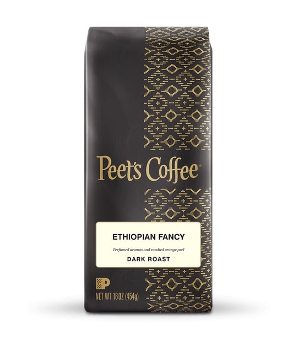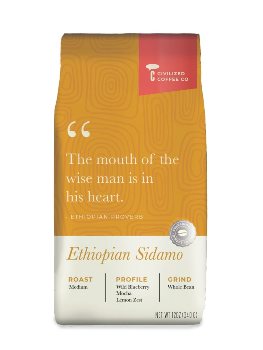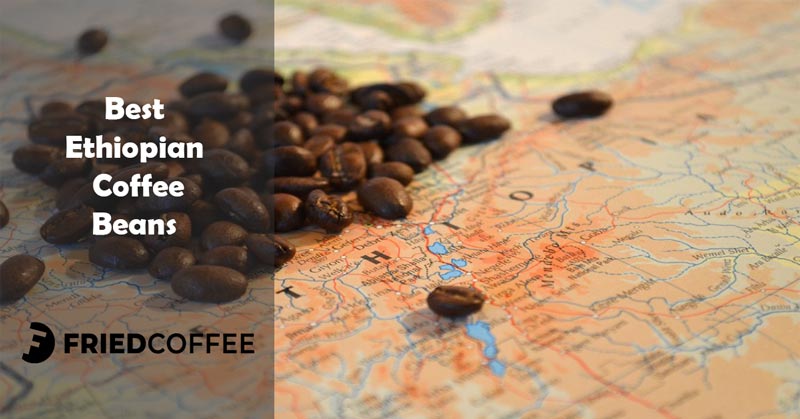
Welcome to Ethiopia, the land of history and culture. If legends are to be believed, this is the place where it all began. It is said to be the site from which the key to the magic potion that over centuries has crawled its way into homes across all the continents of the world was discovered. That’s right! Ethiopian coffee claims its name in the history books as the homeland of the noted brown bean. Some of the very amazing coffee beans come from here.
About Ethiopian Coffee
As of now, there are more coffee-growing regions in the African continent and you already would have heard about Kenyan coffee, Burundi, Malawi, Tanzanian coffee, Uganda, and Rwandan coffee, but Ethiopian coffee is still treasured the most. If you’ve ever wondered about the voyage of coffee from a small country in the horn of Africa, towards global domination; sit back and buckle in, ’cause you’re in for a crazy ride.
Ethiopian Coffee History
The year was 850 AD. The man of the hour was a goat herder named Kaldi. The location was the Kaffa Province, a region that lay to the southwest of Ethiopia. The story goes, that it was a day like any other. And like any other day, Kaldi had left his goats to graze in a field. After some time he noticed them moving weirdly, he almost thought they looked like they were dancing. When he went closer to investigate, it was clear that the behavior of the goats was the result of these new berries that they had eaten.
Intrigued by the fruit, Kaldi, like any good Samaritan at the time, presented his find to the monks in the area. The monks didn’t seem very accepting and deemed the berry as sorcery and the work of the devil. They threw it in the fire as a form of rejection. They were pleasantly surprised by the result and intrigued enough to give it a second chance.
Coffee left Ethiopian shores for the first time during the fourteen hundreds. It is said the beans were requested by monks in Yemen so they could consume the berries for proper concentration during their prayers. A few years later, coffee in the region met religion and was banned by Ethiopia’s orthodox church. The world had to wait till late in the nineteenth century when the coffee cravings of the country’s Emperor Menelik II revived the industry. The rest as they say is history.
Growing Conditions in Ethiopia

The landscape of the country provides the perfect canvas for coffee to grow. Do not be surprised if you find coffee growing in the wild in Ethiopia in what is referred to as forest coffees. Once ready, these berries are gathered by locals of the area. Up to twenty percent of the country’s coffee is sourced this way. Ethiopia does have its share of acres of sprawling coffee fields.
These are usually a part of large estates owned by the government. They account for only a small percentage of the coffee produced in the country. The majority of the coffee in the country grows in what they call garden coffees. This is where you will see the coffee growing side by side with a number of other crops the region cultivates. The altitude in the mountain ranges, an abundance of vegetation, and fertile soil work together to allow most of the coffee crops in the region to flourish without the aid of any artificial chemicals or fertilizers.
Ethiopian Coffee Types
Every region has its own vividness of beans as the climate and geography play an important role in nourishing the outcome. Ethiopia, therefore, gets subdivided into 3 major types of coffee beans classified by the growing regions. Though there are more, these are the most acclaimed and have gained popularity.
Harrar
The eastern part of Ethiopia claims for this region and the coffee is grown in smaller farms. These beans after being bought from farms are dry-processed and are subdivided into the long berry, short berry, and Peaberry. Harrar coffee beans are mostly heavy body, have wine to fruit-like acidity, and an intense aroma of blackberries or blueberries. These beans are often used for creating espresso blends to gather the very fine aromatics within the crema.
Sidamo (Yirgacheffe)
So, the region where this coffee is grown is Sidamo, located in the southern Ethiopian region. It’s mostly known to the world as Yirgacheffe coffee. Most of the coffee fans must have heard this name or better might already have tasted it. This coffee is medium-bodied, mild, has fruity notes, and a floral aroma.
Ghimbi
Ghimbi is located in the western part of Ethiopia. The beans from this region are wet-processed and have a heavier body than the Harrar. They also are more balanced with the longer-lasting body. Ghimbi beans are known for their rich, sharp acidity and complex flavors.
Ethiopian Coffee Flavor – Characterisitcs
So now down to the main question – How does Ethiopian coffee taste?
While the brain first connects the country to Arabica beans; the fact is Ethiopia claims to be home to close to ten thousand varieties of coffee. Some of them have still to be documented and categorized. The varieties you’ll probably encounter can be broadly classified by the regions they hail from. Namely Ghimbi, Sidamo (Yirgacheffe), and Harrar.
The most common connection with Ethiopian coffee is a meld of floral and fruity flavors. These medium-bodied beans are the contribution from Yirgacheffe, a small town to the south of the country.
The richer full-bodied offerings with a sweet and slightly more complex flavor call the area of Ghimbi their home. Lastly, the beans from Ethiopia that bring a slight spicy kick to the drink, are nourished, grown and dry processed in Harrar; a city to the east of the country. The taste of this particular variety has often been compared to blackberry jam.

The method by which the beans are processed after they are grown also plays an important role in altering their taste. When the automatic process, also known as the wet method is used, the result tends to lean towards a crisper taste with a hint of lemongrass and jasmine.
The technique that Ethiopians have been using for eons though, is the natural process through which the fruits remain attached to the bean for a longer period of time. This is why the result is fruity with just a touch of chocolate.
Best Ethiopian Coffee Beans
Since Ethiopian coffee has a legacy that is revered both locally and internationally, the beans from this country are at the top of everyone’s shopping list. With the wise range though, it can be a bit confusing when it comes time to actually pick one. To make life a little easier we’ll walk you through a few of the varieties everyone seems to be talking about, the best Ethiopian coffee brands.
1. Volcanica Ethiopian Yirgacheffe
Roast: Medium-Light Tasting Notes: Lemon, Blueberry, and Blackberry
It is almost impossible to mention Ethiopian coffee beans without talking about the Volcanica Yirgacheffe beans. The name is a pretty strong hint towards the region from where the beans hail. Almost all of the beans in this blend are gathered from wild trees that grow in the shade of the forests of Yirgacheffe. These 100% Arabica beans are grown, processed, and packaged without any interference from outside elements like chemicals, pesticides, or herbicides.
Once brewed, you’re treated to an avalanche of flavors. The medium-bodied blend manages to seamlessly transfer between hints of fruits like guava, strawberry, pineapple, to the taste of both sweet and bitter chocolate. It fishes off with whispers of lavender and cedar and leaves your palate with a wine-like finish. Tempted? Well, you should be.
The beans in the batch you order will only be roasted after the order is confirmed to guarantee fresh produce.
Who is This For?
Anyone who’s looking for that ultimate vibrant and versatile notes in their cups! Start your day with more rejuvenation by grabbing a fruity, chocolaty, and refreshing cup of Volcanica Yirgacheffe!
2. Cooper’s Ethiopian Bold Roast Coffee
The bold brew boasts tartness given by lemon, countered by the floral nectar’s sweetness and raw honey infusions. Each sip of the Bold Brew brings an explosion of flavors to your cup!
Roast: Light Tasting Notes: Lemon Tart, Raw Honey, Floral Nectar
If you’re looking for one of the best Ethiopian coffee variants that creates a bold, flavorful, and smooth cup, this beautiful blend from Cooper’s Gold Roast Coffee is the perfect pick for you. This variety prides itself as one of the best available in the light roast segment. The light roast allows the beans to retain their raw freshness and bring natural flavors directly to your cup!
The Bold Roast continues its theme of natural processing through its precise dry roasting method. The coffee cherries containing the beans are tediously laid out on raised beds and left to dry naturally in the desert sun. This dry roasting maximizes the flavor naturally and brings out the impact of the caffeine with great intensity.
All the beans selected for the preparation of this coffee have passed stringent quality checks. If for any reason, you are not satisfied with the quality of the coffee beans, a full refund is provided within 30 days of the purchase. Roasting is done in small batches, which helps control the flavor profile of the beans with precision.
Who is this for?
This coffee is perfect for those wanting to enjoy lightly roasted brews. The dry roasting retains the natural flavor of the beans and imparts an authentic taste to each sip!
3. Peet’s Ethiopian Fancy Coffee
The inviting smell wafts almost like a light perfume, introducing the lightly lemony taste of the coffee.
Roast: Medium - Roast Tasting Notes: Floral Freshness, Tangy Lemon
Ethiopia is often credited as being the birthplace of coffee, a globally enjoyed juggernaut industry today. From the cradle of this birthplace is the Ethiopian Fancy Coffee, presented by Peet. This elegant coffee is meticulously prepared by the washed method.
To ensure the freshness of the product, the beans are roasted from Monday to Thursday, sealed instantly after roasting, and then promptly shipped. The beans have a distinctive shape indigenous to Ethiopia. They are long, slightly curved, and have a unique floral scent. Peet’s Ethiopian Fancy beans are custom grown and procured from Yirgacheffe, adjacent to Lake Abaya in the Sidamo State in Ethiopia.
The preparation process involves hand-picking the best beans of the Arabica variety and then fermenting them while they are in their ripe pulped cherry state. The coffee is then washed in the pure natural waters of the lake east of the plantation. This creates a peerless flavor and a bright, tangy-tasting brew. Its delicate aroma also distinguishes it.
Who is this for?
Coffee lovers who are passionate about tasting intensely aromatic brews! The bold scent of this brew beautifully introduces notes of tangy lemon and floral freshness.
4. Ethiopian Coffee, Presented by Lifeboost
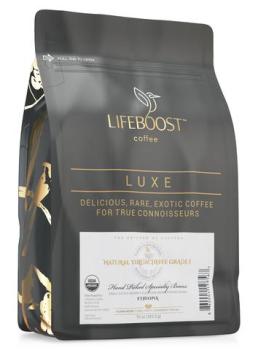
This luxury line of coffee defines exclusivity, and if you aren’t satisfied, a full refund is provided within 30 days of making the purchase.
Roast: Light to Medium Roast Tasting Notes: Floral Sweet, Strawberry, and Peach
The Ethiopian coffee by Lifeboost is a luxury line offering for customers with discerning taste. This delicious, rare, and exotic coffee is released as an exclusive limited-edition offering. The beans are grown organically and are authentically natural.
The coffee provides a unique taste, claimed to be nothing like anything available elsewhere. It is grown in Yirgacheffe in Ethiopia, the region nestled in the birthplace of coffee, responsible for consistently producing coffee beans of the highest quality. The coffee cherries are plucked while still ripe, washed with natural freshwater, and fermented for 72 hours. Biological enzymes are used to remove the fruit and the pulp from the beans. This allows the beans to absorb natural sugars from the bean of the coffee.
A genuinely unrivaled sweet and floral flavor is thus achieved. Each sip of the coffee is brimming with peachy sweetness, which is perfectly paired with strawberry. The tastes mesh beautifully, and instead of making the coffee overly sweet, create the perfect syrupy flavor that leaves you craving for more!
Who is this for?
Coffee lovers looking to explore premium brews will find the Lifeboost Ethiopian to be perfect! This limited edition luxury brew will be perfect for those looking to try statement coffees.
5. Geta Bore – From Broadsheet Coffee Roasters
Roast: Light Tasting Notes: Acidic Lemon, Peach Cobbler
This coffee is produced in Jimma in Ethiopia, a region with a long-standing history of producing coffee beans of the finest quality. It is grown in the fresh mountain air at a high elevation of 2100m, imbuing the beans with a distinctive crispness.
The beans are roasted to perfection until they are lightly medium brown and impart a delicately light taste to each serving. These beans are provided by an Ethiopian collective funded by an NGO. The de-pulping of the beans from the fruit is done in an environmentally sustainable manner. The preparation process is both efficient and minimally wasteful.
The coffee boasts a brightly colorful flavor, accentuated by lemony acidity. This adds a new flavor to the overall profile of the coffee and works inventively with the other vibrant flavors imbued into the blend. These flavors are introduced by an enchanting floral aroma, making this coffee the perfect day-starter!
Who is this for?
This coffee will be loved by those who appreciate authentic Ethiopian brews. The light roast and fruity flavor undertones create magical tasting notes.
6. Ethiopian Yirgacheffe Kochere By Fresh Roasted Coffee
- ETHIOPIAN YIRGACHEFFE KOCHERE COFFEE Is A Well Balanced,...
- SINGLE-ORIGIN FROM KOCHERE, ETHIOPIA. Medium Roast. Heirloom...
- ALL FRESH ROASTED COFFEE IS Kosher Certified, Sustainably...
- ALL OUR COFFEES ARE ROASTED in Our Environmentally Friendly...
Roast: Medium Tasting Notes: Sweet lemon tea , lime and tangerine
Next on our list, we have beans from the region of Yirgacheffe again. Normally we would try to be more geographically diverse, but these beans are just that good. The Fresh Roasted Coffee LLC offers a very refreshing mingle of sweet lemon tea with lime and tangerine. It is the perfect pick for a cold brew to brighten up a hot sunny day.
The blend wears two badges of honor, claiming to be both USDA organic and Fair Trade. So be assured that no harmful artificial elements are impairing the taste of your drink. Additionally, the people working to prepare your blend are treated and paid fairly.
The beans are even roasted in Loring Roasters while taking special note of the carbon footprint they’re leaving behind. The coffee is available as both whole beans as well as pre-ground options.
Who is This For?
Any coffee buff who wants their cups to be smooth, perfect, and naturally versatile. In addition, these pesticide-free beans are low in acidity, ensuring no harmful effect on the stomach!
7. Civilized Coffee Ethiopian Sidamo
Roast: Medium Tasting Notes: Floral and citrus
The next bag of beans on our list hails from the highlands in the region of Sidamo. The altitude and climate in the region allow the coffee to grow without the need for any external aid in the form of herbicides, pesticides, or other chemicals.
The taste of the coffee lies somewhere around a mix of the flavors of the previous two blends on the list. Civilized Coffee Ethiopian Sidamo beans provide a rich texture melding mocha with lemon zest and blueberries.
For the best results, opt to brew these beans using an immersion brewing method like French Press or AeroPress, or pour-over methods like the Chemex or Hario V60. If you’d rather brew yourself a cup of coffee to lift up a scorching summer day, the flavor profile of the blend marries well with a cold brew too.
Who is This For?
Dedicated to those who’re looking for that ever-desired complex yet pleasing cup notes! The wild acidity, winey finish, and smooth, full mouthfeel make these beans the favorite of thousands of coffee lovers across the globe.
How to make Ethiopian Coffee
If you’ve managed to bag yourself a few beans from Ethiopia, there are a number of ways you can choose to brew your batch.
Cold Brew
If you ever feel the weight of a hot summer day pulling you down, a cool cup of coffee can be just what the doctor ordered. Ethiopian beans can best be experienced through a cold brew. It’s the perfect marriage of method and produces. It’s one of the best ways to truly appreciate the fruity tastes of blueberries, blackberries, peaches, melons, apricots, and more waiting to burst out of the beans.

Now, this can be anything from simply sticking your hot coffee in the fridge for a few hours, to brewing hot coffee into a cup filled with ice. But if you opt to use a device specially created for some cold brew coffee; you can opt for anything from the OXO Cold Brew Coffee Maker, Primula’s Burke immersion brewer, the Toddy Cold Brew System, or whatever else suits your needs and tastes.
The cold-brew process is also often the go-to choice for low acid coffee drinkers as hot water is not an element in the preparation process. If this is how you choose to enjoy your daily caffeine, don’t forget to check the freshness of the coffee before you brew. While grind size is always a gamble, this is one of the more forgiving methods of brewing. Start with a coarse grind, and alter according to your taste preference whenever you need your next cup.
Automatic Drip
There’s a famous saying that goes; “In a world full of trends, I want to remain a classic.” And there is nothing more classic to coffee than an automatic drip coffee maker. It’s a no-muss no-fuss method of brewing. And luckily for us, it fits perfectly well with Ethiopian coffee beans. The body of the beans is an important factor in deciding how to brew. The lightness of Ethiopian coffee can be best extracted and experienced perfectly through filter coffee.
Like you should with any other beans you brew, be sure to check the date on the pack. And like you would with any other beans in this method, a medium-fine grind size would be ideal. You’d be surprised at how much of a difference it makes when you get these two things right.
If you’ve got an automatic drip coffee machine calling your house their home, great. If you don’t and are confused about which one to get your hands on, there has been some noise in the market about the BrewSense Drip Coffee Maker, Black & Decker coffee maker, and a few others. Pick whatever suits the needs of your kitchen and the demands of your countertop.
Pour Over

Constructing a daily cup of coffee is often a personal and fairly personalized process for many. And no one would understand that better than the Ethiopians, who have great patience, and take great pride in the creation of their daily coffee.
No other method will give you the amount of control over the various elements that come together to create the perfect cup of coffee that the pour-over does. From the size of the grind to the temperature, flow rate and direction of the water used, and even the rate and speed of extraction. Everything can be monitored and altered from one brew to the next. Whether you choose to use an immersive option like a French Press or AeroPress or prefer to opt for a Chemex, V60, or Kalita Wave, trial and error are what is going to help you get it right.
While it might sound tedious, once you’ve locked in your apparatus and thought through the type of beans you’re going to use, the end result is totally worth it.
What Makes Ethiopian Coffee Different
Coffee is so deeply ingrained in the culture of the country that Ethiopians have created a ceremony that takes place as a part of their daily routine. It truly is a pleasure to witness and is a treat for all the senses. The ceremony that is usually conducted by a woman of the house, works as a thread that pulls the whole family together, with a role for each and every member. The youngest in the family is usually the server, and the first person who served the coffee at a ceremony is usually the oldest male relative present.
Before the ceremony begins, the stage needs to be set. This involves the host laying out a carpet of fragrant flowers and leaves. They also burn incense so that no harmful spirits can’t interrupt the ceremony. A Jebena; a traditional round-bottomed clay pot is filled with water and placed over hot coals.
The Coffee Ceremony + Ethiopian Coffee Brewing Method

The ceremony begins by hand roasting the green coffee beans being used over a live fire. A flat iron pan is usually used for this process. Once the beans start popping and reach a medium brown, they are taken off the fire and placed on a straw mat or at times a clay plate. If you’re lucky to be in attendance at one such ceremony, this is when you can truly appreciate the mesmerizing fragrance of the beans.
Fair warning though, only attend if you have time to spare. The entire ceremony can take up to anything between two to three hours. Once these beans are roasted, a local version of a mortar and pestle called a mukecha and zenezena is used to arrive at a coarse grind size. The beans are then poured into the Jebena. The host of the ceremony takes it on themselves to ensure you’re getting the best result. You might see them tasting the coffee at regular intervals during the brewing process. Once the blend is boiling, it is taken off the heat.
The coffee is usually served in ceramic cups or glasses. They are filled evenly by the host without allowing the dregs of the coffee to fall in. While sugar is an active ingredient in Ethiopian coffee and is offered up at a ceremony, milk is not. If you’re concerned about going hungry during this time, allow us to set your mind at ease. You are usually offered some bread or popcorn with your drink during this time.
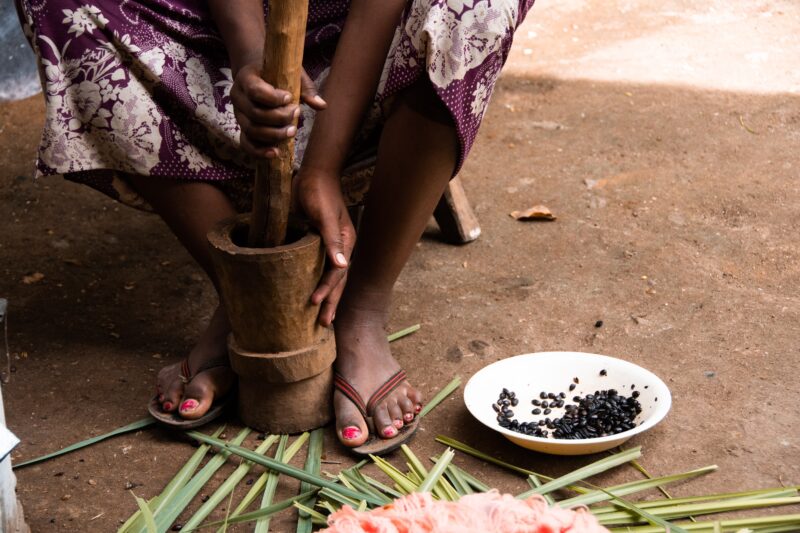
As part of the overall process, frankincense tree sap is burned while you wait for the coffee to brew just to add to the ambiance of the place. Once you’re through with your first cup, more water is added into the pot and the process is repeated roughly two more times.
It is not just a cultural role that coffee plays in the lives of people. Coffee also stands as a special rope that connects the Ethiopian people to their history. For some, it is even the embodiment of their connection to the religion of Islam.
To get an idea of just how vital a role coffee plays in Ethiopian society; you’ll have to hark back to one of the most famous sayings in the country which is “Buna dabo naw”. When literally translated this says “Coffee is our bread”.
Current Scenario of Ethiopian Coffee
Since we’ve already covered the past, it’s only fair to sweep over the present as well.
As of today, Ethiopia stands first in the line of coffee producers in Africa. They hold the title despite the fact that locals consume almost half of what the country grows. The locals are responsible for activity on both sides of the chain. From sowing the crop and nurturing it while it grows to picking, processing, and packaging the berries, and finally, shipping them overseas, over twelve million Ethiopians are involved in ensuring the coffee industry in the country thrives.
Ethiopia’s contribution towards the coffee community of the world tallies at three percent, earning them fifth place on the worldwide stage. As stated earlier, of the total produce of the country, only a small percentage is grown in government-owned estates. The bulk of the country’s coffee is grown in small farms owned by the common people. The country had a system in place, to ensure the farmers were able to sell their crop in a clean and simple process since 2008. However, it wasn’t perfect. Nine years later, a few amendments were added to help smoothen relationships between the farmers growing the crops and the companies selling them to the world.
At the End of the Day
If you ask us, you’d be hard-pressed to find people that put more love and care towards the creation and nurture of the commodity of coffee than Ethiopians. Coffee is an ever-present existence in the lives of the people there. The country respects the bean and treats it well, a fact that is reflected in the end result of caffeine in your daily cup. It comes as no surprise that the world is a fan of the flavor profile that Ethiopia offers. And as far as we can tell, each year only adds new members to the Ethiopian coffee fan club, so it won’t be long till they take over the coffee world.
FAQs
It was only recently, in 2008 that Ethiopia began trading in coffee through the country’s commodity market.
While there is no strict rule, there are houses that conduct the ceremony between one to four times a day.
Close to fifty percent of the Ethiopian coffee calls the continent of Europe their new home. The remaining is split between Asia and North America.
- Everything about the land of coffee – https://www.saveur.com/ethiopian-coffee-buna/
- Coffee production in Ethiopian – https://en.wikipedia.org/wiki/Coffee_production_in_Ethiopia
- Ethiopian Coffee Culture – https://www.thespruceeats.com/ethiopian-coffee-culture-765829


